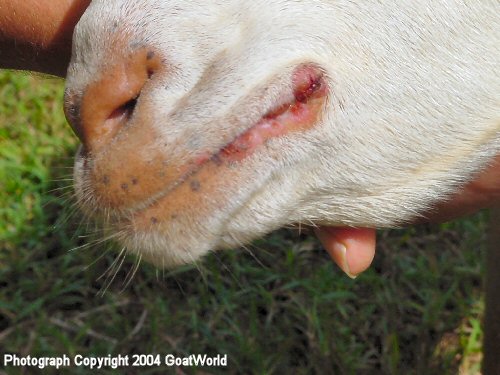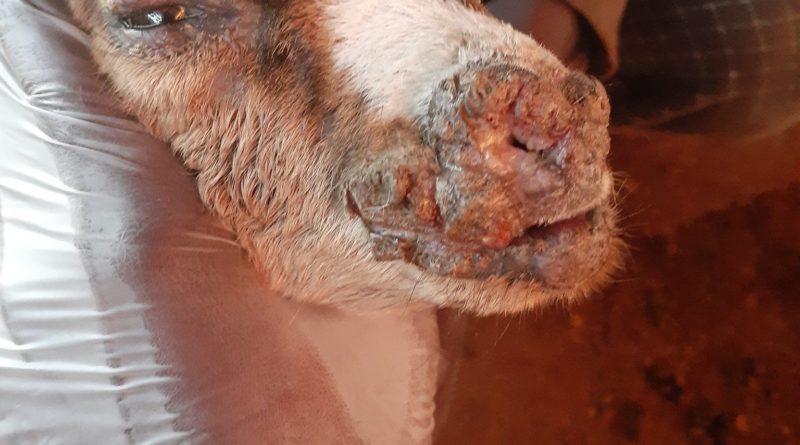Soremouth (orf) in Sheep and Goats
Main Photo: Animal Production with Monnaesi
Sore mouth is the most common skin disease affecting sheep and goats. It is a highly contagious disease caused by a virus in the “pox” family. Sore mouth goes by many names including contagious ecthyma, (contagious) pustular dermatitis, Orf, and scabby mouth.
The distribution of soremouth is worldwide. The disease is widespread in the U.S. sheep and goat population. In a 2011 USDA NAHMS* survey, 43.7 percent of U.S. sheep operations reported having soremouth in their flocks during the previous three years.
Soremouth affects all breeds of sheep and goats. The disease tends to be more severe in goats than sheep. Anecdotal evidence suggests that some breeds may be more susceptible than others (e.g. Boer).
Transmission
In flocks that have never had sore mouth, nearly all animals exposed will develop the disease. The virus is transmitted to susceptible animals via direct contact. The virus penetrates through small abrasions in the skin. Even very minor damage to the skin may allow the virus to enter. Abrasions caused by forage are usually adequate for infection to occur. Carrier or chronically-infected animals may also serve as reservoirs for infection.
Sore mouth can be spread via infected equipment, fences, feed, and bedding. Serious outbreaks can occur in artificially-reared lambs and kids, as they share the same nipples. Showing and exhibition increases the risk of acquiring sore mouth, as livestock frequently have nose-to-nose contact and judges may spread the virus as they examine the teeth and mouths of animals in a class. Vaccinating a virus-free herd will introduce the disease to the herd and premises.
Because they have not likely been exposed to the virus and their immune systems are still developing, young animals are the most susceptible to sore mouth. Older naïve animals can also be affected. Animals that have recovered from natural infection have some resistant to reinfection. However, there are different strains of sore mouth, and it is possible for previously infected animals to become infected with sore mouth more than once in their lifetimes. Infections usually occur several years apart and repeat infections tend to be less severe.
Clinical signs
Once in the skin, the virus begins to multiply. About two to three days after exposure to the virus, vesicles, pustules, and finally scabs appear. Sore mouth lesions occur primarily on the lips and nostrils of affected animals, but may also develop on other parts of the body: e.g. ears, eyes, feet, limbs, udder, and genital areas. Sore mouth affects mostly non-woolly areas. While it can grow in the upper digestive tract of the animal, it cannot spread through the body.

During the course of the disease (1 to 4 weeks) the scabs drop off and the tissues heal without scarring. Sometimes, the scabs harbor secondary bacteria (such as staphylococci) or invite blowfly infestation (screwworms, maggots).
Nursing lambs and kids can spread the disease to the teats or udders of their dams (or other females that they nurse). Teat lesions which develop secondary bacteria can lead to serious mastitis, potentially resulting in loss of the affected udder half and premature culling of the infected female.
Diagnosis
Diagnosis is usually based on clinical signs, along with the contagious nature of the disease. Diagnosis can be confirmed in the laboratory by identifying the antigen in tissue or blood samples.
There are several other diseases (some serious and reportable) whose symptoms may resemble soremouth: foot-and-mouth disease (FMD), sheep and goat pox, and bluetongue. Veterinary assistance should be sought when a differential diagnosis is needed and a more serious disease is suspected.
Treatment
Treatment of soremouth is usually unrewarding. Because it is a virus, soremouth does not respond to antibiotics. Nor is it usually necessary to treat the lesions unless secondary bacterial infection or maggot infestation occurs. Treatment does not speed the course of lesion regression, which is usually about one month. Affected animals may recover only slightly quicker if the lesions are treated.
Treatment of individual animals usually consists of applying salves or antibiotic creams to the lesions. Systemic antibiotics can be used if secondary bacterial infections are severe. It is recommended that the crusts not be removed, as this may delay healing, promote scarring, and increase the handler’s chance of acquiring the disease.
Ewes and does whose udders become infected should receive special care. An udder salve will help to keep the scabs on the teats pliable. In worst cases, the lambs and kids should be removed for artificially feeding. They should not be cross-fostered onto other females as they may infect the udders of clean females. Intramammary antibiotics can be used to prevent mastitis.
Soremouth is rarely fatal, though it can cause significant economic loss. Soremouth lesions are painful to the affected animals, especially young stock. While most adult animals with lesions on their lips continue to eat and produce milk, it may be too painful for young lambs and kids to suckle or eat dry feed. Left unattended, these lambs and kids will become undernourished and more susceptible to secondary diseases. It may be necessary to artificially feed such lambs and kids.
Prevention
Soremouth is best prevented by maintaining a closed and virus-free herd. New animals should be quarantined until soremouth can be ruled out. Unfortunately, some animals can serve as carriers and slip into a flock without detection. Never knowingly purchase affected (or apparently unaffected) animals from a known infected flock.
After a herd is infected, it is difficult to eliminate the disease because the virus can remain stable in the crusts. Scabs that fall from the animals have long been incriminated as the source infection to other animals months or even years later. The virus is a tough one. It contains proteins that interfere with the hosts immune and inflammatory responses.
The soremouth virus can survive for months, possibly years, away from the sheep. Scabs on pasture are not likely to survive the winter, but may survive in barns, pens, and on troughs, feeders, gates, and walls. The virus contain in dried scabs can be infectious for years if maintained in a cool, dry environment.
The vaccine may be used in outbreaks. Affected animals can be isolated, while unaffected animals can be vaccinated to reduce the severity of new cases and shorten the course of infection. If the disease is already well-established, this strategy may not be successful.
Vaccination
Commercial vaccines labeled for sheep and goats are available and may be advised on farms where soremouth is endemic. According to a USDA NAHMS sheep study, 11 percent of U.S. sheep producers vaccinated for soremouth in 2010; 8.1% vaccinated nursing lambs.
The vaccine is made from live virus isolated from ground-up scabs of “modified” soremouth infections. The virus is treated in a way so that it will not cause serious disease, but will produce a mild form of soremouth. Unfortunately, the vaccine does not produce a strong or long-lasting immunity. Vaccination may not always prevent animals from becoming infected, but it may reduce the severity or duration of the disease.
The live virus is infectious to humans. Protective gloves should be worn when handling the vaccine or recently-vaccinated animals. The vaccine should not be used on farms where soremouth has never been known to occur, as it will introduce the disease to the premises and necessitate annual re-vaccination. Recently-vaccinated animals should not be co-mingled with other sheep and goats, as this will spread the virus.
Pregnant females can be vaccinated two months prior to lambing or kidding to prevent natural soremouth from occurring during the nursing period. Vaccinated ewes and does should be moved to a fresh area for lambing and kidding.
The occurrence of colostral immunity in vaccinated animals is disputed. If the vaccine does impart immunity, it is most likely very short-lived. Work with sheep has suggested that vaccinating at the time of drying off may be preferable to vaccinating late in pregnancy. Newborn lambs and kids can be vaccinated if the risk of disease is high.
In herds where buying or showing of animals occurs regularly, vaccination helps to prevent occurrence of a soremouth outbreak during the show season. Animals should be vaccinated at least six weeks (preferably two months) before the start of the show season, so that the vaccine scars will be gone before the first show. Flocks with soremouth are excluded from exhibition until the lesions have cleared up. Health papers will not be issued to farms with active soremouth infection.
Vaccination is usually done on the inside of the thigh of young animals and behind the elbow in adult animals. A woolless area is sought. In goats, the underside of the tail or ear can be used. The area is scratched to make a raw (not bleeding) area. The vaccine is applied to the raw area.
A raised reddened area should result in a few days.
When using the soremouth vaccine, the manufacturer’s directions should be closely followed. Fresh vaccine, which has been stored properly, should be used. The vaccine has a short life, only 10 days.
In people
People can get infected with the soremouth virus when they come into contact with infected or recently-vaccinated animals. Handling the live vaccine can also result in infection. People handling infected animals or vaccinating sheep and goats should wear protective gloves at all times. Hands should be washed immediately after handling affected animals.
As with animals, soremouth can cause painful lesions in people. The lesions are usually on the hands. The sores may last for two months and usually heal without scarring. In rare cases, soremouth causes serious illness in people.
Orf is self-limiting in hosts with normal immune systems. However, skins lesions can resemble more serious infections, such as cutaneous anthrax. A laboratory test for soremouth is available at the Centers for Disease Control (CDC).
Original article: shorturl.at/oBC47



